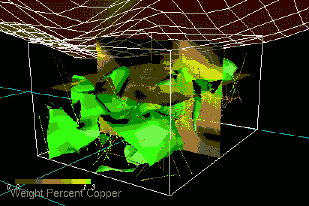CHARACTERIZING COPPER DEPOSITS

ABOVE: The distribution of copper deposits buried inside a mountain in Chile is revealed through nearly half-a-million assay measurements collected from 11,000 bore holes. Crunching numbers drawn from vast data sets can help determine the best strategies for recovering subsurface deposits of metals and minerals, or reservoirs of gas and oil. The technique is greatly facilitated when the resulting numbers, through the power of NERSC's supercomputers, are translated into easily understood 3-D images. |
Critical to the success of any numerical modeling is the interpretation of what the model's final numbers mean. In the case of models involving geophysical processes, the volume of data generated is enormous. Such data can be made much more comprehensible, hence much more beneficial, if it is translated into a recognizable 3-D image.
Berkeley Lab's Visualization Group has been doing this for several different geological research groups with eye-catching results. One project involves researchers in the Lab's own Earth Sciences Division and UC Berkeley's Department of Geology and Geophysics. They are looking at the distribution of the copper that remains inside Indio Muerto, a mountain in northern Chile that has been heavily mined for the past 50 years.
Millions of years ago, Indio Muerto was an extremely wet area, now it is one of the driest places on earth. The change in climate above the surface of the mountain has had an effect below the surface. Rich copper deposits close to the peak were leached down through the interior of mountain by the dropping water table. With the perspective provided by 3-D imaging, the ESD and UCB researchers can now show the result of this leaching in a dramatically clear fashion.
The images reveal that, through the eons, deposits of copper have been heavily concentrated in select areas within the mountain known as "enrichment blankets." These enrichment blankets turn out to be located close to existing mining operations, which means that the lifetime of the mines will be extended another 10 to 15 years with minimal consequences for the environment.
The imaging techniques used to illustrate exotic copper deposits in Indio Muerto can be applied to other metals as well as to other models of subsurface geological and hydrological activities.
 PART FOUR: UNCOILING THE MYSTERIES OF DNA
PART FOUR: UNCOILING THE MYSTERIES OF DNA
PART SIX: PICTURING QUARK THEORY
